by Winding Pathways | Jul 3, 2025 | (Sub)Urban Homesteading, Flowers/Grasses, Foraging, Garden/Yard, Pests
A Variation on “The Four Horsemen”
A quartet of deadly and toxic plants lurks along trails and riverbanks in Iowa and some across much of the world. They are Poison Hemlock, Poison Ivy, Flowering Spurge, and Wild Four O’clock.
Poison Hemlock
We’ll start with Poison Hemlock. Socrates wasn’t the only person killed by it. The Greeks once used to execute criminals.
Poison hemlock isn’t related to the majestic hemlock tree. Rather, it’s a biennial herbaceous plant. In its second year it quickly shoots up to tower upwards of eight feet tall. In Iowa it prefers living in dappled sunlight where the soil is moist. That describes the land bisected by public trails paralleling rivers and streams—places where people go to recreate.
It’s deadly poisonous, but only when ingested. Walking or cycling by it creates no problem at all. But it’s wise to know about this potentially deadly plant. All parts of it are toxic to people and animals when ingested. Even dried, wintery stems are poisonous.
By early June, the tall green plants with feathery leaves begin bearing white clusters of flowers. Their prettiness is deadly.
Poison hemlock could be confused with Queen Anne’s Lace that’s sometimes called wild carrot. Poison hemlock also often lives near wild parsnips. This plant is also toxic, in a different way. It can create a vicious rash in people who rub against it with bare skin and then are exposed to sunlight.
Where Poison Hemlock Originated
Poison Hemlock is native to Europe and is especially common around the Mediterranean Sea. It was introduced to the Americas, New Zealand, Australia, and Asia, so today, it is a toxic invasive species worldwide.
The Internet and YouTube are loaded with sites describing this plant. A good quick read comes from the National Park Service at nps.gov/articles/poison-hemlock.htm.
Other Troublesome Plants
Unfortunately, several other deadly and toxic plants often live in the same places as poison hemlock. Here are a few.
- Poison ivy often lines trails. It prefers living on the edge of woodlands where it gets some shade and sun. Unlike poison hemlock, poison ivy is a native plant that causes a contact reaction. That means if human skin brushes against it a nasty itchy rash can follow. And, if a pet wanders through the poison ivy and then comes inside where a human pats it, guess what? The irritating oils are transferred and the human gets a nasty rash. A friend of our discovered this earlier this year. Also, state parks are notorious for having poison ivy growing where people contact it – along unkempt trails and winding up trees in campgrounds even. Rabbits and deer eat it and birds eat and spread the seeds.
-
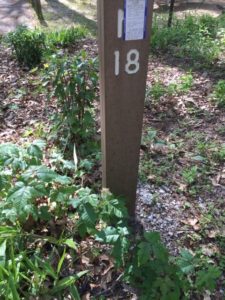
-
Birds drop seeds when they perch on campground posts.
-
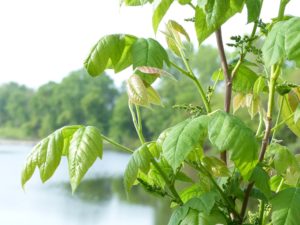
-
Poison Ivy loves edges
-
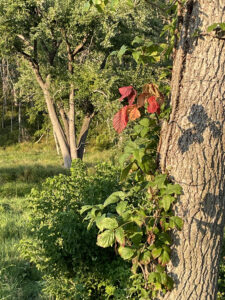
-
Keep your distance from this beguiling, colorful plant.
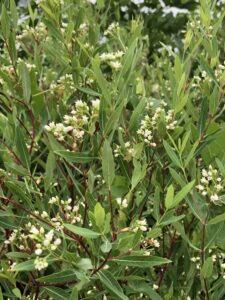
Pretty and irritating
Flowering spurge is also common along trails. Cut the plant and get some of its sap on skin and a nasty welt is likely to result.
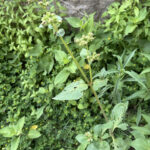
Unattended areas attract undesirable plants.
Wild Four O’clock also loves trail edges and is reported to be toxic.
None of these plants cause problems unless they are eaten or contact the skin. They won’t cause a problem for anyone just walking by
Be careful. Keep your distance.
by Marion Patterson | Jun 26, 2025 | (Sub)Urban Homesteading, Garden/Yard, Mammals, Pests
What’s In A Name?
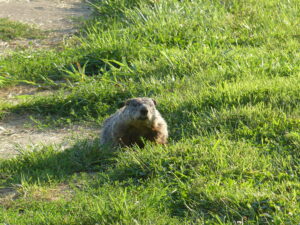
Nibbling on grasses
A big furry animal has made a tunnel under the deck and clear cut down the garden. Is the culprit a woodchuck or groundhog? The answer is simple. They’re two names for the same animal.
The window by Marion’s computer desk overlooks our deck. On a spring morning, she was startled to look out and be face to face with a big woodchuck just outside the glass.
He soon ambled off. A few days later, we were enjoying basking in the sun in our outdoor nook. It’s next to a front lawn that we seeded with white clover last year. Out of the corner of our eye, we caught movement. It was the woodchuck, likely on his way to enjoy a clover lunch. When he spotted us, he quickly exited.
What is a Woodchuck?
Several species of marmots live across the northern hemisphere. Visitors to western national parks often see the Yellow-Bellied Marmot in higher elevations, but the one most Americans spot is the amazingly abundant woodchuck.
Woodchucks live in both suburban and rural areas from the Atlantic Ocean westward to Nebraska and Kansas and north to Hudson’s Bay and even Alaska.

Woodchucks are great tunnelers.
They are an amazing adaptable vegetarian. Among North American rodents only beavers are bigger. A huge male “chuck” can weigh up to 15 pounds. As rodents they have impressive incisor teeth and powerful legs perfect for digging burrows under decks or inside or near old sheds and brush piles.
True hibernators, male woodchucks emerge from their burrows in March here in Iowa. Females wait a few weeks and usually end their winter slumber in April. They’ll soon have three to five pups. As soon as the babies’ eyes open, mom will bring them outside where they learn to dine on a wide range of vegetation. They love garden vegetables. Perhaps nothing is as tasty as beans, lettuce, or Swiss chard.
Tree Climbers?
Most people realize woodchucks are excellent diggers, but few recognize they are squirrels adept at climbing trees. On hot summer afternoons, they love resting on a shady and breezy tree branch.
Reducing Woodchuck Damage
Although they’re big and active during the day, woodchucks are wary and usually vanish when they spot a person. They can’t hide the huge mound of dirt by their burrow, and a clear-cut bean patch also may mark their presence.
How do you reduce woodchuck damage? Since they can burrow, run, and climb, it’s challenging keeping them out of a yard or garden.
These Actions Can Help
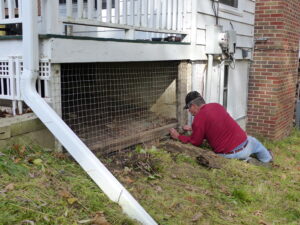
Rich placing wires to prevent woodchucks from digging under the porch.
Fencing: A stout fence around a garden or deck can make access challenging. The fence needs to be dug into the ground. Placing a mesh of stout fencing on the ground under a deck will reduce the odds that a chuck will burrow there, but it has to be done before the animal starts making its home.
Dog: An alert dog will chase chucks away.
Altering the yard: Removing brush piles where chucks like to burrow will encourage them to create a home elsewhere.
Trapping: Woodchucks are usually easy to catch in a box-type live trap. Set the trap near the burrow and bait it with bits of apple or other fruit. It helps to cover the trap with a tarp or some brush, as they feel more secure underneath something.
There’s a problem
What do you do with a healthy but very unhappy chuck caught in a box trap? Keep fingers out of the trap! Call the town animal control officer(s) and ask for their suggestions on what to do with it. We don’t advocate taking it on a long drive and releasing it in the country. It seems unethical to “give” the animal to someone who lives near the release area. Preventing damage is always best, but sometimes euthanizing a problem chuck is the best solution.
Woodchucks are amazing animals. We enjoy seeing them as long as they stay out of the garden!
by Winding Pathways | Jun 19, 2025 | (Sub)Urban Homesteading, Flowers/Grasses, Garden/Yard, Garden/Yard
Years ago, anyone attempting to create a diverse, native landscape in their yard sometimes experienced weed ordinance woes. Their local ‘weed commissioner” would order them to mow their “messy” yard.
Towns created ordinances to give them the authority to force landowners to remove what was perceived to be health or safety hazards. But, they were sometimes used to enforce conformity to the standard of neatly mowed, sprayed, monoculture lawns promoted by lawn product and care companies.
Cities do need the authority to deal with situations where landowners simply neglect their yards by not mowing, but they should not be able to use ordinances to enforce an aesthetic standard.
Changing Times – Responding to Declining Pollinator Populations
These days, homeowners everywhere recognize the importance of diversity. They are creating diverse landscapes of native plants even in tiny yards. Towns are responding by altering restrictive ordinances to allow the restoration of beautiful vegetation that supports beneficial wildlife, including pollinators.
Anyone who plans to diversify their yard in a way that makes it look different from their neighbors’ runs a risk of running afoul of their local town’s ordinance.
Guidelines To Reduce Neighbor or Municipal Friction.
- Research your town’s weed ordinance. Often, it’s printed on the town’s website.
- Develop a written plan and diagram of what the yard will become. It doesn’t need to be fancy or detailed.
- Cultivate and educate neighbors. Even towns that have old-fashioned ordinances rarely go out of their way to enforce them. Enforcement is triggered by complaints, usually from neighbors. Sharing a yard’s plan with neighbors before the change takes place may help them understand that what you are doing isn’t neglect.
- Start small. Maybe just replace a corner of a yard with prairie the first year and expand it gradually as the years go by.
- Make the yard look tended and not neglected. This can mean mowing pathways through tall grass, maintaining some lawns, and often being seen tending the yard tending the landscape.
- Avoid health or safety hazards. Avoid planting taller vegetation that will block a driver’s vision at intersections. Don’t allow allergens like poison ivy or ragweed to grow.
- Hiring a knowledgeable professional yard care company to plan and implement diversity.
Results
Restoring a gorgeous landscape of native vegetation is a delightful project that makes our world a bit healthier. Doing so is easier if it doesn’t irritate neighbors or invoke a stern town ordinance.
-

-
Native and cultivated plants brighten a front yard.
-
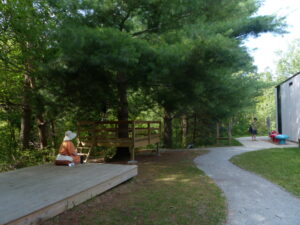
-
Families outside
-
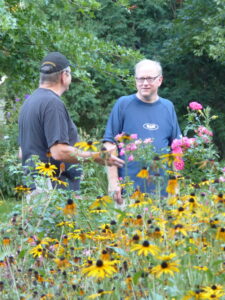
-
Converting a yard to more natural plants brings joy.
This first appeared on the Sustainable Landscape Solutions Website at sustainable landscape solutions.org. The company is based in Iowa City, Iowa, and helps landowners create wondrous yards.
by Winding Pathways | Jun 12, 2025 | (Sub)Urban Homesteading, Nature, Reflections/Profiles

Tracks easily run over a rough surface.
On a spotless spring day, Trackchair® made a delightful afternoon in nature’s beauty possible.
Marion had had surgery, so walking on soft or uneven ground during recovery was challenging. But it was May, the marvelous season of birdsong and wildflowers. We yearned to leave urban noise behind and hike a trail.
Why Nature?
Few activities are as refreshing, relaxing, and rejuvenating as being in nature’s stillness and beauty. For most people, all it takes is a walk in the woods, wetland, or flower-studded prairie. Marion’s walking challenges were temporary during recovery, but many people lack easy access to nature due to a permanent disability.
How We Got Outside
We made a reservation to use one of three Trackchairs® that the Indian Creek Nature Center welcomes people to use for free. Two are adult sizes, and one is designed for a child. The chair was charged up and ready to go when we arrived at the Nature Center. Staff member Michelle Basler gave us a quick orientation. “I love helping people use a Trackchair. They help people who usually use a wheelchair to venture into nature alone or with their more mobile friends or family,” she said.
The Nature Center’s Trackchairs® are made by ATZ Manufacturing in Marshall, Minnesota. “We have a nationwide system of distributors making it possible for nonprofit organizations, like the Nature Center, or individuals to purchase one and have it tailored to their needs. Distributors also service the chairs,” said Adam Henning, Marketing Manager.
How Trackchairs(R) Help
He told us the chairs are being used by a diversity of people with special needs. “We know they give access to nature for people close to the end of their lives. Even injured seasoned athletes use them to observe outdoor sports,” he said.
Our time outdoors wasn’t exactly quiet. We were serenaded by Baltimore Orioles, Rose-breasted Grosbeaks, Tennessee Warblers, and American Redstarts. Wildflowers lined the trail. The Trackchair(R) itself was so quiet we could hear birds as the chair purred along on its electric motor. “Quietness is important. Various ATVs on the market enable people to access nature, but they are noisy,” said Henning.
Friendly Features
The chairs are also easy on the ground. Marion used the joystick to turn the chair 360 degrees, and it barely scuffed the grass underneath. It has a leveling feature that enabled her to go up and down steep slopes without concern of tipping, and gingerly cross a narrow footbridge.
Where to Rent a Trackchair(R) Locally and Why

Controls are easy to learn.
We were fortunate to have access to one of three Trackchairs® recently purchased by the Indian Creek Nature Center in Cedar Rapids. “The Nature Center held a fundraising campaign to find money to buy the chairs and additional endowment funds to generate income to pay for their maintenance and eventual replacement costs,” said John Myers, Executive Director.
“The Nature Center strongly believes in the many mental and physical health benefits of being outdoors. The Trackchair® helps us extend access to those people who struggle to walk,” said Sarah Botkin, who manages the Nature Center’s Amazing Space Building.
The Indian Creek Nature Center is a private nonprofit organization on the east side of Cedar Rapids, Iowa. Annually, it hosts thousands of people for environmental education programming, special events, and rentals. Trails wind through over 400 acres of woodland, prairies, and wetlands and are open to the public for free use every day of the year. For information or to make a Trackchair® reservation, visit Indian Creek Nature Center and the reserve an all terrain wheelchair. You can learn more about AMZ Manufacturing and the many models of chairs they make by visiting their site.
What Is A Trackchair(R)?
ATZ Manufacturing made the Trackchairs® and is based in Marshall, Minnesota. It began in 2008 when a father worked to develop a device to enable his son to access the outdoors. It grew into a company that makes and distributes the Trackchair® we used and many other models suited to different needs. “We have one that enables people to stand and do things like grilling dinner,” said Henning.
Trackchairs® weigh between 400 and 500 pounds. They are best transported in a pickup truck or enclosed trailer, but can be moved on a hitch platform that has a tongue rating of at least 700 pounds. Transportation, of course, isn’t necessary at the Nature Center or the many other nonprofit organizations and government agencies that let people use them on their grounds. They move at three to five miles an hour and have about a seven-mile electric range. “We’re working to increase the range using advanced batteries,” said Henning.
Overall Impression

A Trackchair(R) helps people with limited mobility enjoy being outside.
We were amazed at the chair’s comfort, its quietness, and its ease of learning. After just a few instructions from Michelle, we were on our way up and down the Nature Center’s trails. Even after turning on a mowed section of the trail, the grass was undisturbed. The slower speed gave a leisurely pace. Time to note flowers and hear birds. The faster pace on rough ground was akin to riding a bronco. Kind of fun, but not recommended. The chair has a guard on the back to prevent tipping over. And, users can angle the seat forward or slightly back when going up or down steeper hills.
It was awesome to use!
An Update
About a week after we tried the Trackchair® Rich was volunteering at the Nature Center. A school bus drove in and unloaded a class of fifth grade students. One was in a wheelchair with an attendant. The Nature Center had the youth-sized chair ready and a staff member oriented the student right after he was transferred into the Trackchair®.
Then, off he went with his classmates. The chair enabled him to pace right along with the other students on his own. He was thrilled.
by Winding Pathways | Jun 5, 2025 | Energy Efficiency, Ruminations
Buying a KIA Niro in the fall of 2024 ended several months of seeking the best car for us. Our Chevy Cruze was serving us well. We liked it but it was a low-set vehicle. At pushing age 76 we were finding it harder to get in and out of it. So, we went on a quest seeking an ideal car.
We wanted a car that was easy to get into and out of, got exceptionally good gas mileage, was comfortable to drive and ride in, and was well built and durable enough to last for years.
EV or Plug-In Hybrid?
Although we were intrigued by an electric car, often travel takes us to rural areas where charging stations don’t yet exist. So, we sought a plug-in hybrid that would let us buzz around town on battery power yet allow us to use gas for longer jaunts.
McGrath Motors
We needed help locating the right car for us. Garrett Ellard at McGrath Motors in Cedar Rapids proved to be an outstanding resource. He listened to our needs and had us try a few models. One was a plug-in KIA Niro, a model we had never heard of. We liked it and purchased it through KIA’s lease-to-own program. This reduced the purchase price, but became complicated and problematic.
Complications
We picked the car up in November 2024 and have been driving it for half a year.
Here are aspects of the car we like:
- It is easy to get in and out of, and is comfortable to drive and ride in.
- The plug-in electric feature is outstanding. We plug it into a 110-volt wall outlet. We didn’t need to hire an electrician to install a faster charger.
- KIA says the car will run on battery power for 33 miles when fully charged. As expected, it does somewhat less than that during very cold weather, but exceeds the range during warm days.
- The car seamlessly switches automatically from electric to gas power when the battery is depleted. It has equal and plenty of power, whether in battery or gas mode.
- When driving on trips with the battery depleted, the KIA gets over 50 miles per gallon on gas. Once with a headwind, it exceeded 60 mpg.
- Safety items are amazing.
Here are a few things we found challenging or perplexing:
- KIA’s lease-to-own program: We were told that we’d receive a purchase price about $4,000 lower if we leased the car for three months and then made the purchase. That is a chunk of money, so we chose this. It became a frustrating, time-consuming process. We thought when we paid for the car in February 2025, we’d “own” it, but it initiated two months of signatures, changing out temporary plates, and just plain aggravation. Perhaps the dealer or KIA didn’t want us to buy the car, but just continue to lease it. This was resolved, but if the option of lease-to-buy comes up in the future, we would approach it cautiously.
- The electronics are amazing and do remarkable things, but many of them we don’t need or use. For example, it’s easier to turn on the radio in our 19-year-old Chevy truck than in the KIA. Feel for the knob and push it. With the KIA, one has to take their eyes off the road, if the driver, to find the radio function, if it is not one, and push the screen. Seems dangerous. The Cruise control is harder to use than in our old car, and when it’s not on, it’s difficult to manually hold the car at a steady highway speed. The car wants to go faster than the speed limit!
- The gearshift is actually a wheel. Again, the driver has to take eyes off the road to determine if in drive, park, or reverse because the gear shift is between the seats. Also, dangerous because the shift can get bumped and then create situation of loss of control of the car. A gear shift lever is safer. We are used to the wheel, but it is unsafe.
- What WERE the engineers thinking? Novelty is one thing, safety another. We vote for safety.
All in all it’s a great car.
by Winding Pathways | Mar 27, 2025 | (Sub)Urban Homesteading, Home Improvements
- Disclaimer: Both Milwaukee and Ego have provided us with tools to test, however, we purchased most of our tools at retail cost, including Milwaukee and Ego brands.
There it was, printed clearly in the owner’s manual. Clean the tool.

Review the owners manual before operating a tool.
I’d just bought a Milwaukee Brand Random Orbit Sander. Even before handling it I fished the owner’s manual out of the box, wrote the date of purchase and location I bought it on the manual, and leafed through it. Included were clear instructions on the importance of cleaning the backing pad.
Test and Clean
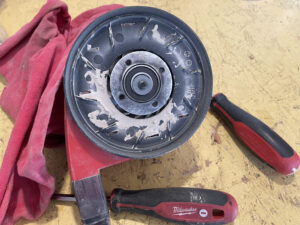
Wood dust on bottom of sander.
After testing my new sander, I unfastened the backing pad to find a surprising amount of wood dust packed in crevices. A bit of work with a brush and rag, combined with brisk blowing, swept the debris away, making the sander ready for its next use.
“It’s important to keep all tools clean, lubricated and well maintained. Saws, grinders, and sanders tend to create much debris that can lodge inside them, said Pete Carlson, my tool mentor and and an employee of Milwaukee Tools. “Keeping them clean helps the tool run efficiently, and safely,” he added.
Habit
I think I’m unusual. Right after buying any mechanical device, whether it is a new refrigerator, fishing reel, or tool, I write the date of acquisition on the owner’s manual and include where I bought it. Then I leaf through the instructions and place them in a permanent file for future reference. I also use a Sharpie pen and write my name and the purchase date on the new item. Above all, I immediately clean the tool when done using it.
Read the Manual
Reading the manual helps me learn the capabilities of a tool or reel that I didn’t know. Instructions also clearly detail maintenance needs and sometimes include troubleshooting and repair information if there’s a problem.
At Winding Pathways, we use chainsaws, trimmers, mowers, and snowblowers for outdoor land management and a diversity of carpentry tools for home maintenance. Years ago, I bought a starter kit of battery-powered Milwaukee brand tools and have built on the system often. I love ‘em for their efficiency, ease of use, and safety.
Lesson from the Army
Back in Army trainee days my squad’s crusty drill sergeant wouldn’t let us go to chow after a tiring day until we’d thoroughly cleaned our rifles. We were usually starved but knew the sergeant was right. It became a habit. Now, after a chainsaw session I may be tired and hungry but the priority is cleaning and sharpening the saw.
Clean the tool.
Rich’s Tool Tips
- Buy quality tools, but before using one read the owner’s manual.
- Wear protective gear. Usually, that means hearing and eye protection, sturdy gloves and shoes, and, when chainsawing chaps.
- Clean every tool after use.
- Keep cutting tools sharp, lubricated, and well-maintained.
Respecting Tools
Tools are amazing. They make the most difficult chore easier and faster. But they should be treated with care and respect and used safely.
Sourcing Tools

Side view with date of purchase.
Most of our tools are either the Milwaukee or EGO Brand. We like them both and occasionally buy a new tool to run on their battery systems. As we buy new tools or replace old ones, we tend to buy Milwaukee for the quality and convenience of using one battery system. Other companies sell quality tools as well.
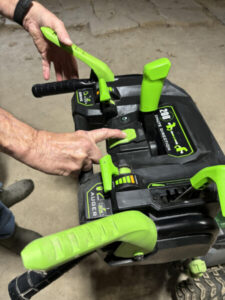
The snowblower starts with a push of a button.


















